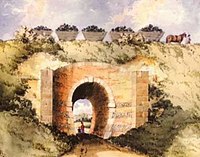Surrey Iron Railway

Watercolour showing the Croydon, Merstham and Godstone Railway passing Chipstead Valley Road, Coulsdon, Surrey
|
|
| Locale | England |
|---|---|
| Dates of operation | 1802–1846 |
| Track gauge | 4 ft 2 in (1,270 mm) |
| Length | 9 miles (14 km) |
| Headquarters | Wandsworth |
The Surrey Iron Railway (SIR) was a horse-drawn plateway that linked Wandsworth and Croydon via Mitcham, all then in Surrey but now suburbs of south London, in England.
It was established by Act of Parliament in 1801, and opened partly in 1802 and partly in 1803. It was a toll railway on which carriers used horse traction. The chief goods transported were coal, building materials, lime, manure, corn and seeds.
The Croydon, Merstham and Godstone Railway was built as an extension of the railway but by a separate company. It opened in 1805 and closed in 1838.
The Surrey Iron Railway was commercially successful only briefly, until shortly after the opening of the canal between Croydon and London in 1809. It closed in 1846.
By the end of the eighteenth century, a number of short plateways, such as those to the Caldon Low quarries and the Little Eaton Gangway, had been built. Their purpose was to convey a mineral to a nearby canal for onward transport.
The original plan for a transport connection between Wandsworth, on the River Thames, and the industries of the Wandle Valley had been a canal scheme, put forward in 1799, but doubts about the availability of water led to the adoption of a plateway. Contrary to popular belief, it was not the world's first railway authorised by Parliament independently of a canal: that was the Middleton Railway (1758). Nor was it the first public railway or the first railway company: both of those honours go to the Lake Lock Railway near Wakefield, Yorkshire.
It received the Royal Assent on 21 May 1801, and work commenced immediately with William Jessop as engineer, George Leather as resident engineer, and joint contractor with Benjamin Outram. The line started at a wharf on the Thames at Wandsworth, and ascended gently through Tooting and Mitcham to Pitlake Mead in Croydon. There was a branch from near the site of the Mitcham Junction to oil-cake mills at Hackbridge, and a number of spurs to mills and works.
The initial share capital was £50,000 to which a further £10,000 was added in 1805-6. The final cost, including the dock at Wandsworth, was between £54,700 and £60,000. The main traffic was coal, building materials, lime, manure, corn and seeds. Horses were the motive power, and passengers were never contemplated.
The railway was only briefly successful financially. It lost much traffic after the Croydon Canal opened in 1809, though the full effect was not felt until the canal acquired a rail link to the two railways in 1811. Later it suffered from the closure of the underground stone quarries at Merstham in the 1820s. It covered its costs, but was unable to update its technology or to keep the track in good repair. It closed on 31 August 1846.
...
Wikipedia
